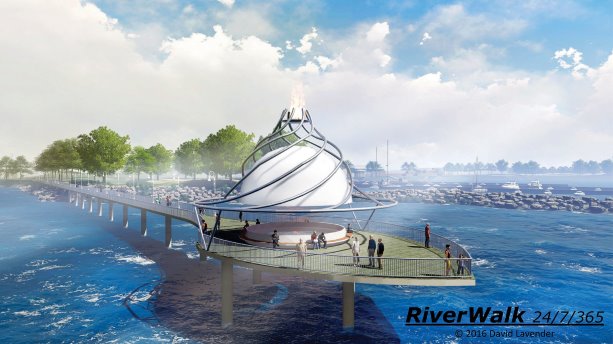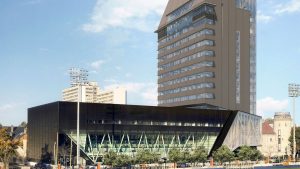Sarnia, Ont. was built on a three legged stool — its First Nations, and Chemical Valley workers in both the steel and the chemical industries.
Sarnia architect David Lavender wants to honour all three with an ambitious plan to construct a 200-metre boardwalk in time to coincide with Canada’s 150th birthday in 2017.
Lavender’s work on the proposed project has been entirely voluntary. He says he believes that RiverWalk 24/7/365 could be built for around $2 million and could qualify for significant provincial and federal funding that would also attract private donors. However, he hasn’t yet been able to convince enough Sarnia city councillors to commit to a "low level study" required to ensure that the project could qualify for funding.
He says that he would like to see the project located at the end of a pedestrian path that terminates on the city-owned Point Lands near the marina on Sarnia Bay.
"It peters out around the area where I would want to see the RiverWalk located," says Lavender. "This would make it a destination for people on the pedestrian path or the Bluewater Bike Path."
The boardwalk itself would be traditionally constructed, using steel or concrete pylons, a concrete or wooden deck and stainless steel guard rails. The design concept for the end of the pier is what makes it special.
"I designed a pavilion that would have some really interesting steel work," says Lavender. "It would resemble the type of stainless steel piping typically used in Chemical Valley. The structure would form a curvilinear framework that would represent the wigwams built by First Nations as summer dwellings in the area. Underneath the structure would be a translucent dome about 30 feet in diameter made of Chemical Valley plastics. The dome could be lit from within and be topped with a flame representing the fine metal work created in the area."
Lavender says he designed the structure with no moving parts to ensure low costs for construction and ongoing maintenance. He also approached private engineering consultants who worked for the city who said they saw no obvious impediments to construction.
Lavender provided his concept images to Sarnia newspapers, inspiring a positive response from citizens, Tourism Sarnia Lambton, the Sarnia Community Foundation and the Rotary Club of Sarnia. Next stop was a presentation on May 9 to city council, offered as a simple information session.
"I made a 10-minute presentation, including a video, and explained that we would require $30,000 in seed money to take the predesign to the point necessary to make all the applications to the various government agencies for fundraising," he says. "However, I was never really looking for seed money from the city."
Council members noted that staff would first need to conduct a low-level feasibility study before the city could become a proponent of the project. To Lavender’s surprise, council brought the idea up for an immediate vote. The motion to direct staff to complete the feasibility study was narrowly defeated, four to three against.
"To be truthful, I could have done more homework," he says. "But I don’t do these sorts of presentations every day."
Lavender believes the project could be funded 50 per cent by private businesses, organizations and individuals, and 50 per cent by government — without city financing.
"However, somebody needs to be the lead proponent of a project like this and the city is the natural lead," he says.
But RiverWalk isn’t dead. Lavender is looking at other ways to complete the feasibility study on behalf of the city, so that the predesign phase can begin. He’s also looking for private assistance to complete the predesign study.
"In general, the nature of Sarnia is that if 72,000 people in the city think it’s a great idea, it will happen," he says. "Enough public input will get it back on the table."




Recent Comments
comments for this post are closed